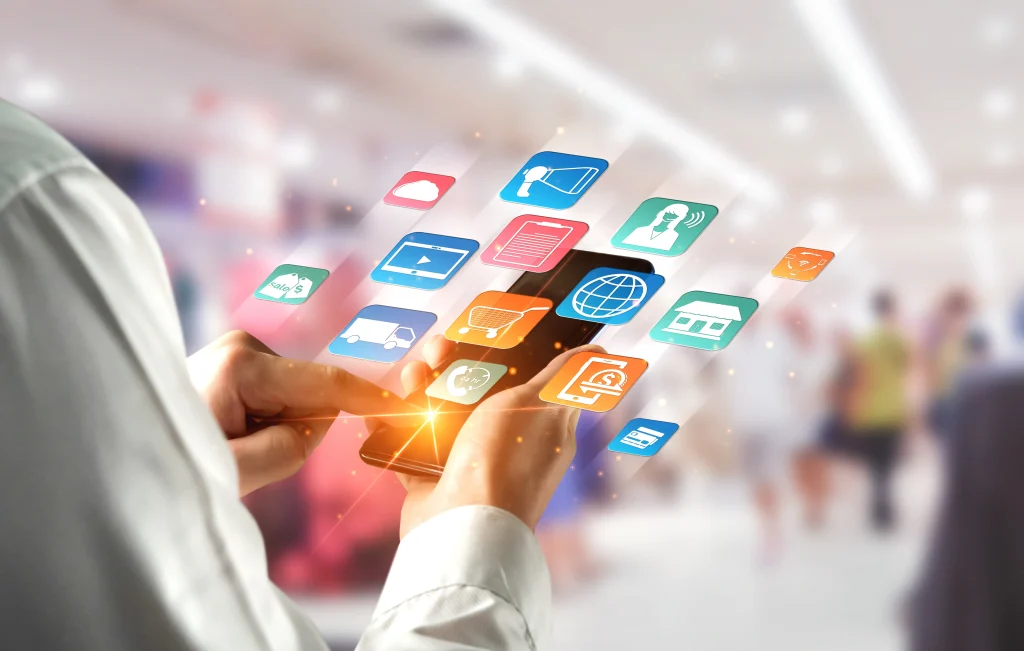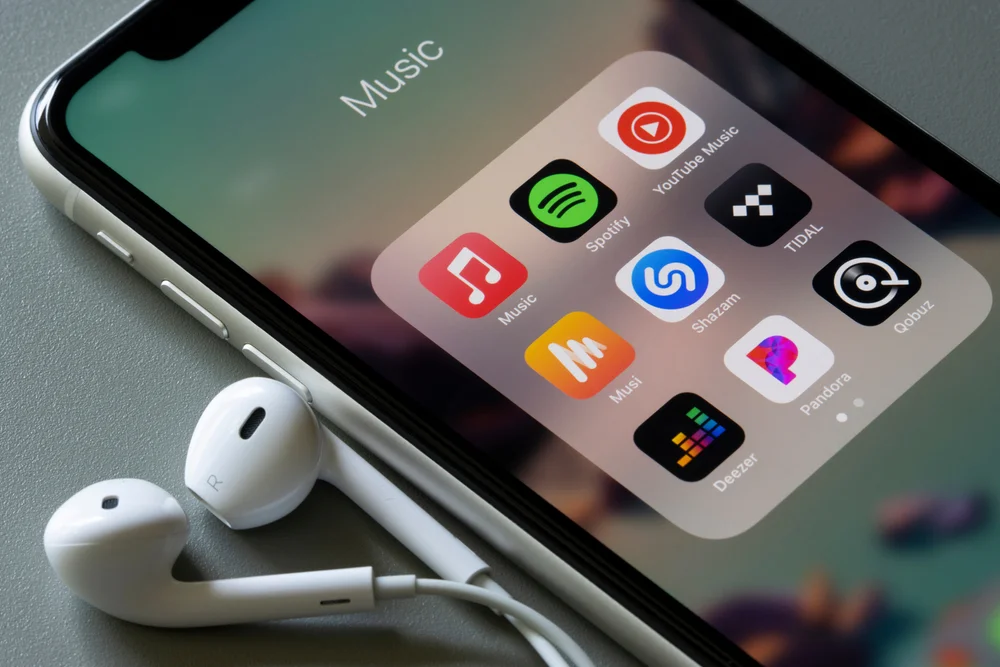At a time when companies are redoubling their efforts to retain their talent and boost their overall performance, employee engagement has become a key strategic issue. But how do you sustainably nurture the motivation of your teams, encourage buy-in to shared objectives, or make internal communication flow more smoothly?
The answer lies in one word: game.
Integrating play into the company in its managerial practices or HR actions can profoundly transform the organisation’s culture. More and more employers are incorporating in-house competition games, QVT challenges or even edutainment schemes to energise their teams’ day-to-day work. This is what we call gamification in companies.
Much more than just a trend, this approach helps to strengthen team cohesion, make information sharing more fluid and consolidate the feeling of belonging to the organisation. It can even become a real lever for boosting your employer brand or optimising your recruitment process.
If you’re facing these challenges in your workforce, this comprehensive guide to gamification in companies will give you all the keys to understanding how it works, its benefits, and how to effectively integrate it into your HR strategy.
What is gamification in companies ?
Gamification in companies consists in integrating game-based mechanisms into non-game-based professional contexts. The aim of this initiative can be to stimulate commitment, motivation or even adherence to the organisation’s culture.
In practical terms, this means transposing elements such as challenges, a points system, rankings and rewards into a working environment. This could be a training course, an internal communications campaign or a recruitment process.
Where does gamification in companies come from?
The term “gamification” first appeared in the early 2000s, but the concept really took off from 2010, driven by the rise of digital and interactive interfaces. Initially used in marketing and customer loyalty, the principle quickly found fertile ground in business, particularly in HR and managerial areas.
Gamification is also part of the movement towards <a href="https://www.adictiz.com/blog/ludopedagogie-jeu-et-apprentissage/
“>ludopedagogy, this approach that values learning through play. It is based in particular on the dynamics of objectives, progression and the pleasure of interacting with teaching material and other learners.
Gamification is now finding its place in a variety of professional contexts. It can range from corporate competitions to training, corporate communication programmes and QVT challenges.
Among companies that adopted gamification early on, the example of Cisco is often cited. Back in 2011, the American firm introduced a gamified training programme based around social networks. In particular, the training path included a system of levels, badges and league tables to encourage employees to develop their skills.
Another striking example: Google used gamification to encourage its employees to choose the most economical travel options by converting the savings made into points and rewards, a simple but effective mechanism for encouraging new behaviours.
6 concrete applications of gamification in companies
Corporate gamification can be applied to many HR and managerial levers, with concrete, measurable benefits. From recruitment to team building and internal communication, every issue can be addressed with targeted gamification mechanisms, such as company competition games or QVT challenges.
Here is an overview of the principal concrete applications of gamification in companies.
1. Recruitment: identifying talent differently
In a tight jobs market, companies need to stand out from the crowd to attract the right profiles. Gamification applied to recruitment makes it possible to create an engaging experience from the very first interactions, while enhancing soft skills.
For example, recruiters can gamify recruitment at each stage:
- Phase 1: Talent detection – Launch a competition game on its social networks or via a school partnership, in the form of an interactive quiz or speed game based around its professions or corporate culture.
- Phase 2: Fun qualification – Integrate a serious game or a situation simulation game to assess key skills (project management, creativity, decision-making).
- Phase 3: Collaborative selection – Use a scoring or ranking system to visualise the best profiles and encourage internal discussions around their potential.
Example: The British Air Force set up the “RAF Mission” game.This immersive simulation allowed candidates to project themselves into different operational roles and test their reflexes and abilities. A strategy that paid off, increasing the conversion of visitors into candidates.
2. Onboarding: facilitating the integration of new arrivals
The first few weeks are decisive for a new employee. Gamification of the onboarding process helps to make the experience more interactive, while promoting information retention and cultural integration.
companies can set up a “treasure hunt“-type game or an interactive course. New recruits have to validate missions to discover services, tools or key colleagues. By adding a visual progress bar, talent will be able to track their progress more easily and HR teams will be able to support them in a targeted way as they integrate.
Example: Deloitte has introduced a gamification system into its induction pathway, particularly for its online training courses. For example, the organisation has added badges and rankings to motivate module completion.
3. Training: learning while having fun
Edutainment transforms learning into an engaging experience. In companies, this makes it possible to transmit knowledge more effectively and stimulate learner involvement.
For example, organisations can deploy a timed quiz (like a Trivia) or a mission-based game with instant feedback and a points system. These mechanics encourage active memorisation and make progress monitoring more transparent.
Example: DPD, via its My DPD for Business platform, deployed an internal campaign aimed at its employees to help them discover the new shipper customer area. Thanks to a fun Quiz designed to test their knowledge, the operation generated strong internal commitment, demonstrating the effectiveness of gamification in supporting change and encouraging the appropriation of new tools.
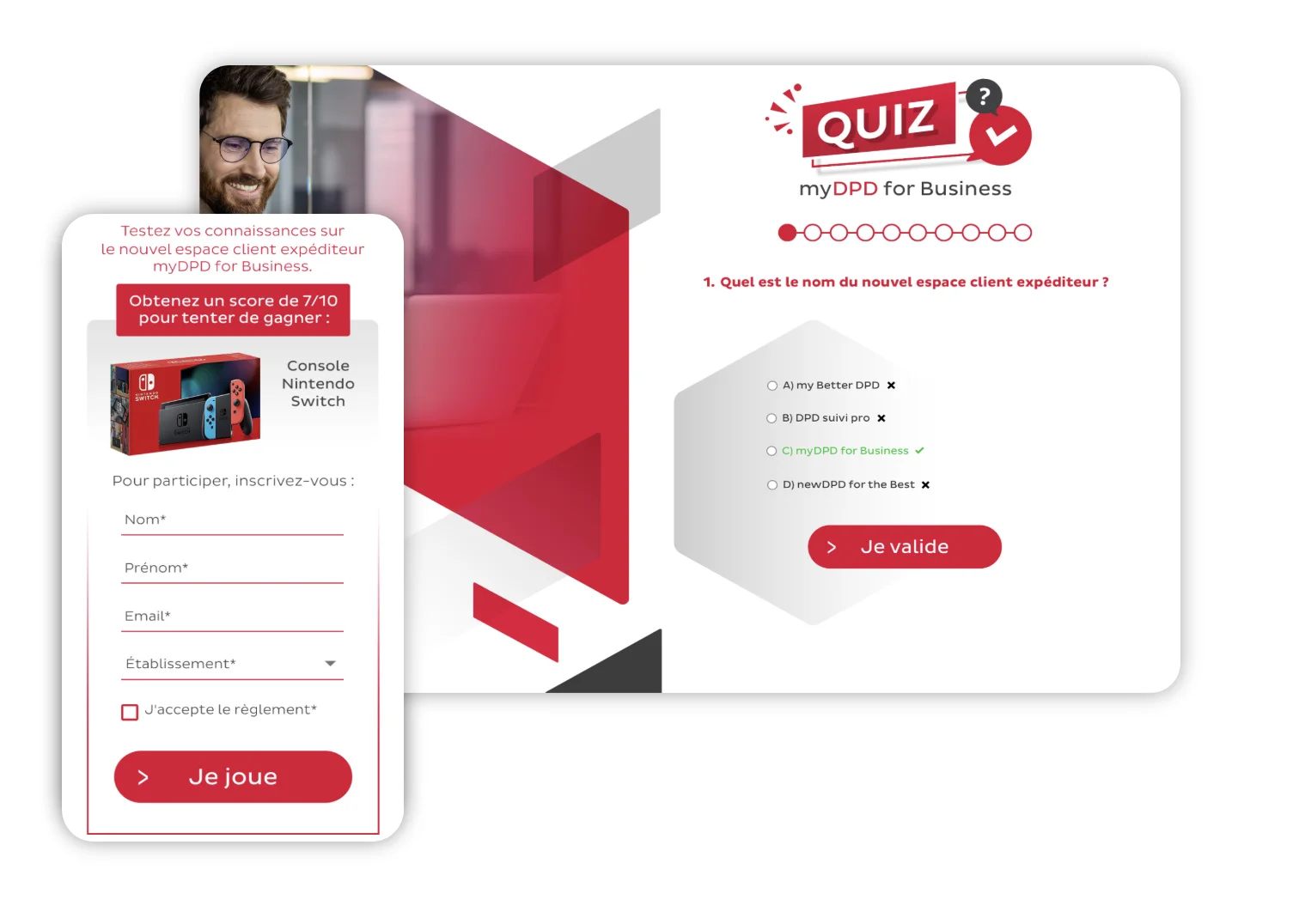
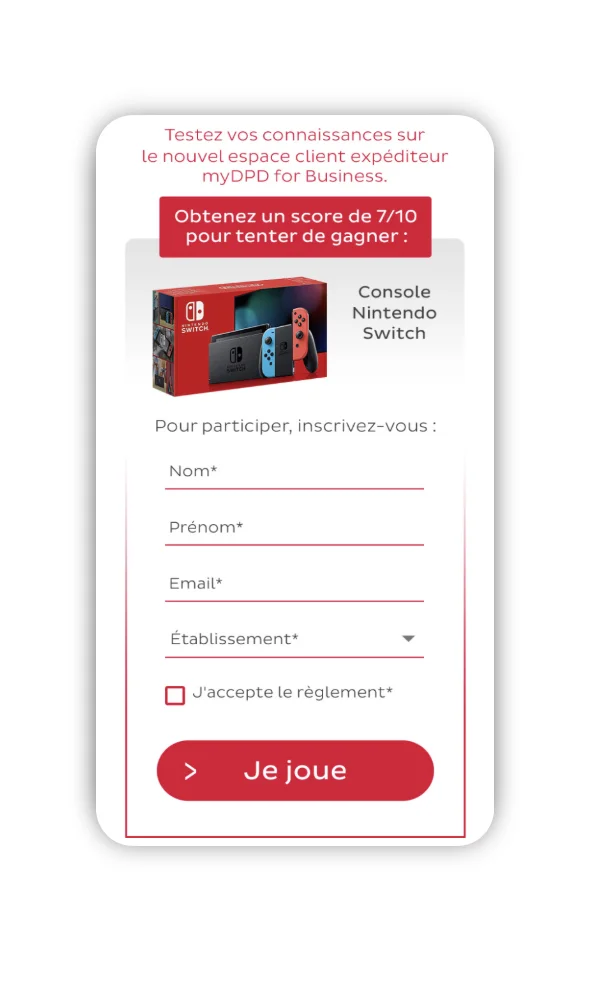
4. Employee commitment: motivating through play
Motivating your teams on a daily basis, valuing their efforts and reinforcing the feeling of belonging are pillars of collective performance. Gamification makes it possible to create rituals to boost employee commitment.
A good way of engaging people through games is to offer regular internal competitions based around commercial, innovation or collaboration objectives. Weekly rankings and recognition badges create healthy competition between teams and strengthen the engagement dynamic.
Example: We are Lidl, the chain’s employer brand, launched an operation to engage its employees around the Next Level programme, which combines sales training, performance, CSR and corporate culture. Thanks to the mechanics of Match 3 and its final ranking, the game was able to mobilise the teams by creating a competitive and motivating dynamic. This fun approach strengthened their commitment while anchoring Lidl’s values at the heart of the experience.
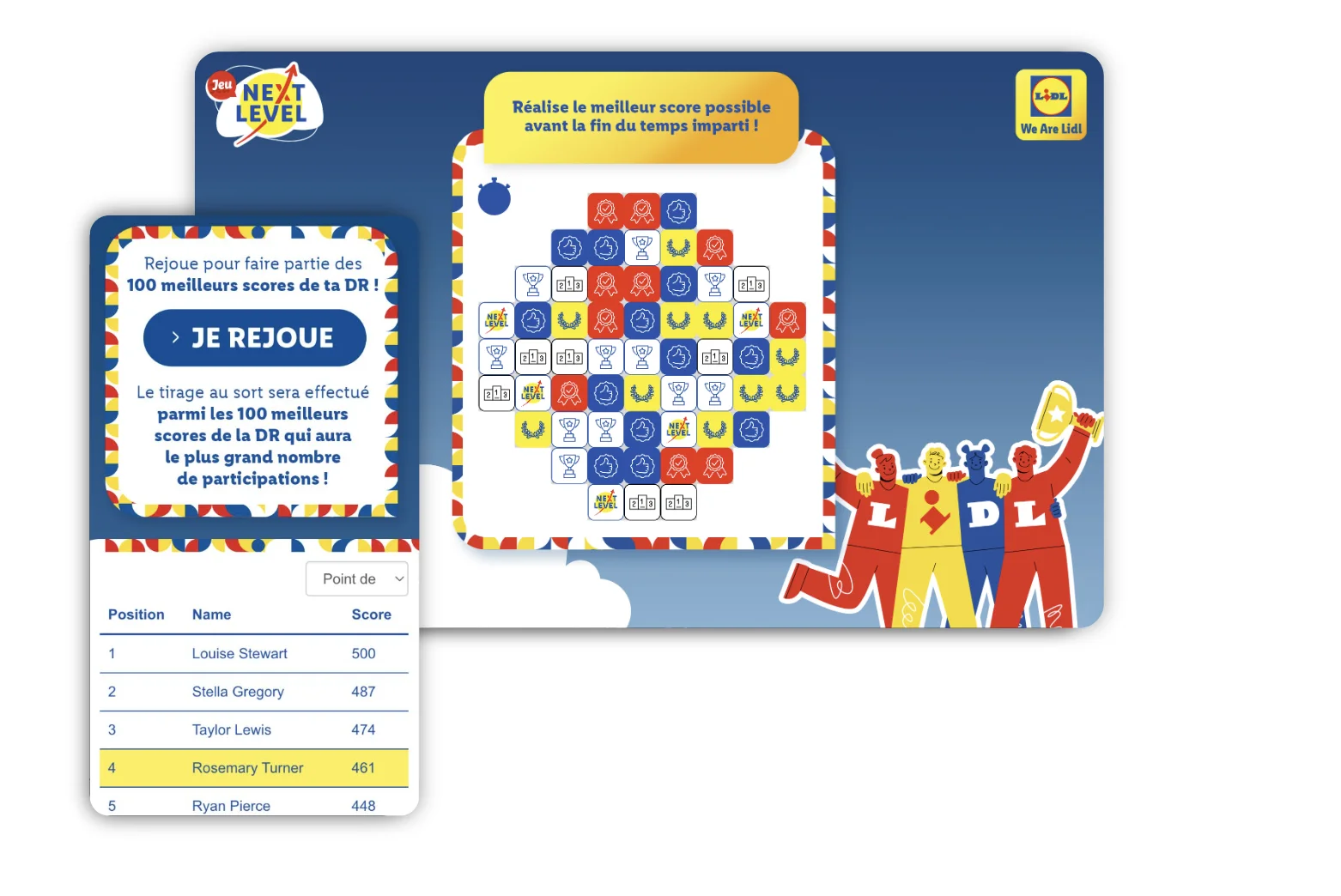
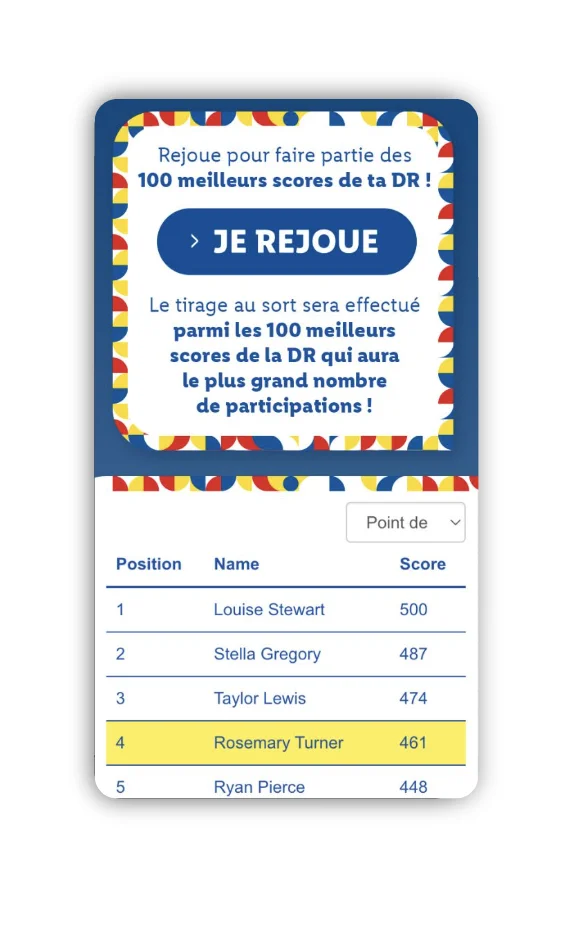
5. Corporate communication: strengthening understanding of internal issues
Corporate communication initiatives are sometimes perceived as descending (thought up by management and not always adapted to teams) or not very captivating. Incorporating games into them encourages the messages to be appropriated and stimulates team participation.
For example, employers can offer a multiple-choice quiz with visual storytelling to introduce employees to their CSR policy or a new corporate strategy. Scenario-based games allow employees to become completely immersed in internal subjects and improve understanding of the organisation’s strategic challenges.
Example: A year after the launch of its Connexion 2026 strategic plan, DPD wanted to mobilise its employees around CSR issues by offering them the chance to test their knowledge of the various actions undertaken within this framework. Through an internal game campaign, the company was able to combine education and commitment, with a high level of participation from teams, proof of their interest in the values promoted by the programme.


6. Leading teams : QWL, health and solidarity
Challenges are an increasingly popular format in the workplace. Whether they’re about solidarity or health, they help to improve quality of life at work, encourage virtuous behaviour and create opportunities for sharing.
A connected challenge, for example, can encourage employees to adopt a more active lifestyle. The company can set up a device to count steps, invite teams to carry out solidarity actions or take part in wellbeing quizzes.
Example: Adictiz, for example, organised an in-house QWL challenge to encourage the adoption of reusable cups. We opted for the Customizer mechanic, an interactive game that invited participants to personalise the object with the visual of their choice in order to boost its use.
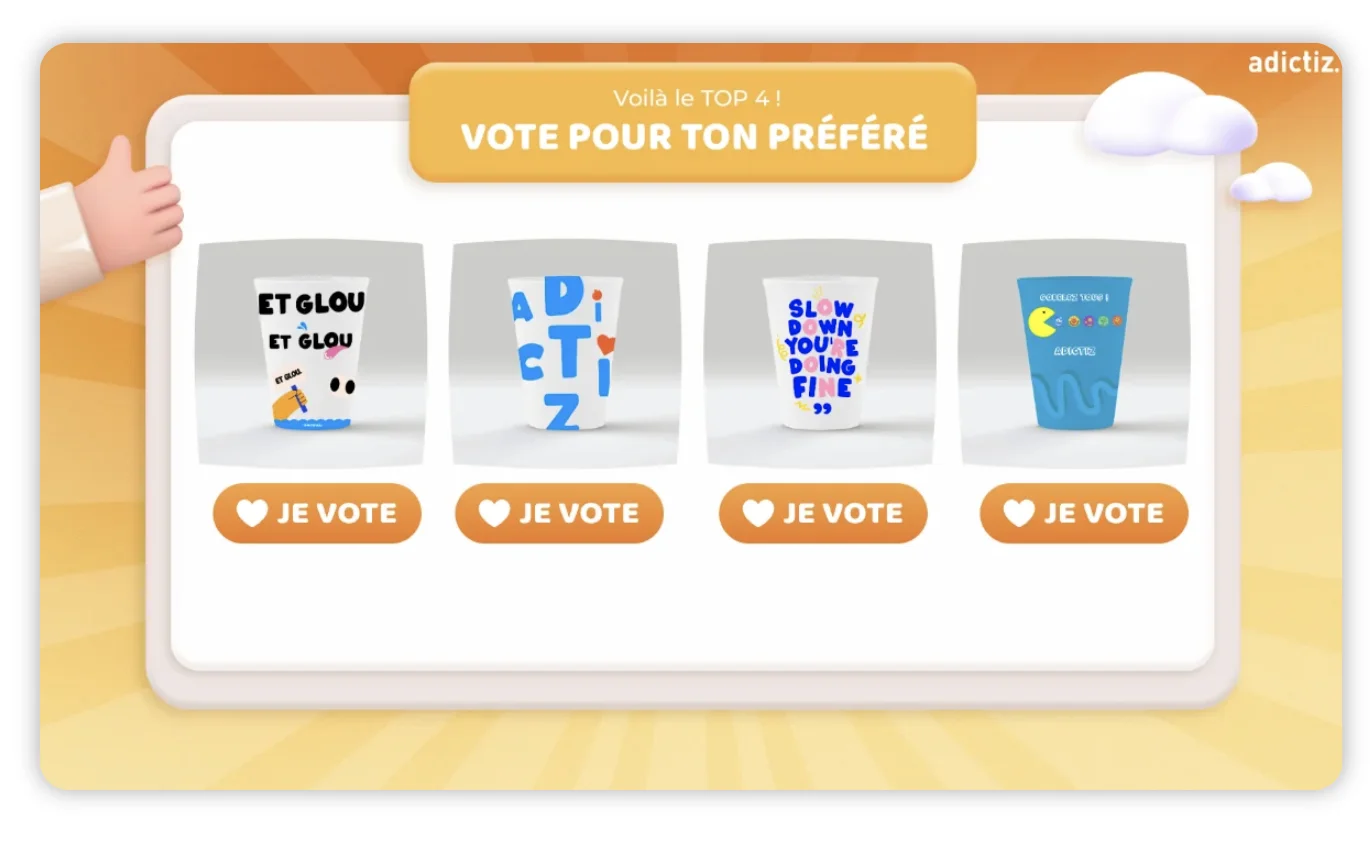
The benefits of gamification for companies
Adopting gamification in business isn’t just about “adding fun” to the day-to-day lives of teams. Above all, it’s a strategic lever for creating an attractive working environment and boosting the organisation’s collective performance.
Here we will decipher the principal benefits of play in business,backing this up with evidence.
1. A more attractive working environment
According to Gallup, only 21% of employees in Europe say they are engaged at work. Yet a playful environment improves well-being on a daily basis, and in turn, the attractiveness of the company.
Introducing game mechanics into the workplace transforms professional routines into more engaging and motivating experiences. This fosters a more positive climate and a more dynamic corporate culture.
2. Greater employee commitment
Games involve, mobilise and empower. Well thought-out gamification gives meaning to objectives while making the journey towards achieving them more motivating.
A study by TalentLMS in fact shows that 89% of employees feel more productive and motivated when their work is gamified. To illustrate this statistic, we can cite the example of Microsoft. The tech giant incorporated a game system to encourage its employees to test beta versions of software. This has enabled thousands of bugs to be corrected thanks to the voluntary and massive participation of the teams.
3. Strengthened team cohesion
Playing in-house favours group dynamics, mutual support and informal exchanges. When a challenge or QVT challenge is collective, it strengthens solidarity between departments and generations.
A study published in the Journal of Business and Psychology suggests that team building games can improve collaboration effectiveness by 50%.
4. Boosted productivity
Games make it possible to transform performance objectives into motivating challenges. The corporate game competition, with a well-designed rewards system, can encourage people to exceed their objectives while maintaining a positive dynamic.
According to a study conducted by Deloitte, 83% of companies that have adopted gamification solutions have seen a significant increase in the involvement of their teams and productivity 17% higher.
5. Better talent retention
When employees find meaning and pleasure in their work, they are naturally more inclined to stay. Gamification in business, by providing recognition and appreciation, is a factor in retention.
A recent study conducted in a technology company shows that setting up a points and badges system to reward skills acquired can lead to a 50% reduction in staff turnover.
6. A dynamic brand image, both internally and externally
A company that is innovative in its internal practices, particularly through in-house competitions or fun events, also stands out externally. This positively feeds the employer brand, but also the perception of the company by its customers and partners.
The L’Oréal group, for example, set up the “Brandstorm” game, an international challenge aimed at students, but also at its employees. This initiative helped to enhance the company’s culture of innovation and attract talent while uniting teams.
Tutorial: how to get started with gamification in business in 6 key steps
Let’s finish with a step-by-step guide to effectively structuring your corporate gamification approach, while ensuring its adoption and impact.
1. Carry out an accurate HR diagnosis
First and foremost, it is essential to identify the real internal issues: disengagement, staff turnover, lack of cohesion, difficulties with onboarding, or even sluggish internal communication.
Setting up anonymous surveys, workshops or interviews can help to better understand employee expectations. Analysis of the current employee experience can also be cross-referenced with benchmarks from companies that have already incorporated gamification levers. This will enable us to build a targeted and effective gamification strategy.
2. Choosing the right tools
A dedicated gamification platform makes it possible to design tailored in-house competitions, distribute them across several channels (email, intranet, QR code, etc.) and monitor performance in real time. The technical automation offered by this type of solution leaves more room for strategic thinking and running the campaigns.
3. Select the right mechanics
The choice of format must directly respond to the objectives identified. A game with stages can structure onboarding, a scoring quiz encourages the assimilation of training content, and a collaborative game can strengthen team cohesion.
Other formats such as the QVT challenge or a competition with rankings are also pertinent for energising internal highlights. A well thought-out mechanic maximises employee engagement and message memorisation.
4. Careful communication around the game
The success of a fun operation depends largely on how it is presented. Clear and engaging communication, before, during and after the activation, helps to generate interest and ensure strong participation. Teaser, relaunches, rewards, valuing the results: each stage must be integrated into the overall corporate communication strategy.
5. Managing the experience
The human facilitation of the scheme plays a key role over time. It is important to maintain a regular link with the participants, to encourage them, to reward their efforts or to relaunch less active teams. This closeness strengthens involvement and helps maintain a collective dynamic throughout the game.
6. Measure and learn
Once the activation is complete, data analysis (participation rates, completion rates, score progression, qualitative feedback) allows the concrete impact of gamification on teams to be assessed. These insights are used to adjust the mechanics, improve content and refine the strategy for future internal campaigns.
Conclusion
Corporate gamification is therefore a powerful lever for optimising your HR processes and offering your teams a healthy and fulfilling working environment. The success of a corporate gamification project depends as much on the upstream strategy as on the execution.
With the right tools and the right support, you can create high-impact, motivating gamification experiences for your teams. Discover our interactive mechanics and boost your performance with gamification!






